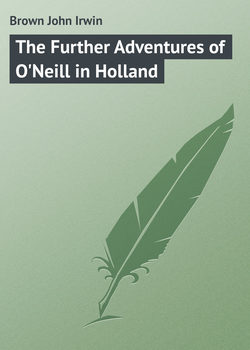Читать книгу The Further Adventures of O'Neill in Holland - Brown John Irwin - Страница 3
CHAPTER III
HOW O’NEILL LEARNED TO PRONOUNCE
Оглавление“I never could quite understand,” said Bart van Dam, the big Cape giant, who had carried off Boyton the week before, “how O’Neill managed, out of such an extraordinary book, to pick up anything of the pronunciation. For, as a matter of fact, he does get quite close to some of the sounds; and I can nearly always guess what he is trying to say.
“When he is talking about that interesting Rotterdam street, the Boompjes, he doesn’t make the first part rhyme with the English word loom, and then add cheese, a thing I have heard Britishers do who should have known better. And actually, I have noticed he can distinguish goed, groot, goot. That’s promising.
THE GOAT THAT RAN ROUND THE ROOF
“Some of my British friends at the Cape, even after I graduated on English Literature and History, used kindly to drop Dutch words into their conversation, either to make it easy for me, or to keep up my spirits, so to speak. Oh never a talk of over five minutes, but little familiar terms like taal, zolder, maar, and so on, would begin to be showered in, here and there. One of these linguists had taken me into his own back garden, (he was very fond of animals of all kinds and we had gone out to inspect those he had) when he began to explain the new improvements on his premises.
We got into a deep discussion on the right way of draining a flat roof. “Come here”, said he, at last. “Look up there, and you’ll see a goat of mine running all round the open space!”
“Goat!” I exclaimed; “it’ll fall!”
“Nonsense”, he said, “not unless lightning strikes it. Firm as a rock! Now, isn’t that the right sort of goat to carry the water off?”
He thought he had said goot in Dutch!
Well now, Jack’s beyond that. Who had been coaching him?
A HAS A BROAD SOUND
Naturally I turned up Boyton on pronunciation the very first thing at home – and the mystery was solved! I was amazed. Boyton excels in teaching the sounds. Here is an extract or two from his
REMARKS ON THE DUTCH PRONUNCIATION.
There you have some of the Rules! They won’t lead you far wrong, in any case. Then, to crown all, for fear the diligent reader wouldn’t have caught the point yet, Boyton goes back to his favourite “Doctrine of the Native.” Here it is:
The Editor places the learner on his guard against receiving wrong references, and directs him to an Instructor, or Native, whose Dialect it is, for the sound peculiar to each letter.
NATIVES
Bravo, Boyton!
Three kinds of Natives he recommends the beginner to consult. He has them arranged in a sort of ascending scale —the Civilized, the Intelligent and the Polite.
The two former classes will help you with the pronunciation, or with Het.
From the latter you get idioms.
